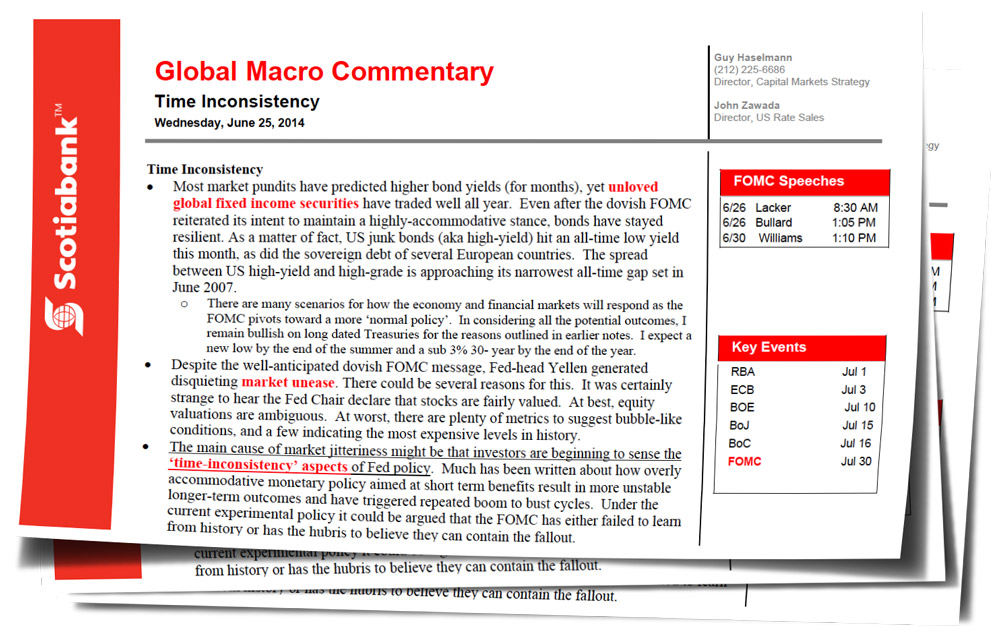Time Inconsistency
by Guy Haselmann, Director, Capital Markets Strategy, Scotiabank (Global Banking and Markets)
• Most market pundits have predicted higher bond yields (for months), yet unloved global fixed income securities have traded well all year. Even after the dovish FOMC reiterated its intent to maintain a highly-accommodative stance, bonds have stayed resilient. As a matter of fact, US junk bonds (aka high-yield) hit an all-time low yield this month, as did the sovereign debt of several European countries. The spread between US high-yield and high-grade is approaching its narrowest all-time gap set in June 2007.
o There are many scenarios for how the economy and financial markets will respond as the FOMC pivots toward a more ‘normal policy’. In considering all the potential outcomes, I remain bullish on long dated Treasuries for the reasons outlined in earlier notes. I expect a new low by the end of the summer and a sub 3% 30- year by the end of the year.
• Despite the well-anticipated dovish FOMC message, Fed-head Yellen generated disquieting market unease. There could be several reasons for this. It was certainly strange to hear the Fed Chair declare that stocks are fairly valued. At best, equity valuations are ambiguous. At worst, there are plenty of metrics to suggest bubble-like conditions, and a few indicating the most expensive levels in history.
• The main cause of market jitteriness might be that investors are beginning to sense the ‘time-inconsistency’ aspects of Fed policy. Much has been written about how overly accommodative monetary policy aimed at short term benefits result in more unstable longer-term outcomes and have triggered repeated boom to bust cycles. Under the current experimental policy it could be argued that the FOMC has either failed to learn from history or has the hubris to believe they can contain the fallout.
• There is a less obvious ‘time-inconsistent’ aspect worth mentioning. My paper “2014 and Beyond” stated that “holding interest rates at zero for a prolonged period is actually counter-productive to the Fed’s efforts of achieving either of its dual mandate. This is because increasing productivity through modernization typically exposes redundancies: it allows firms to lay-off workers, while the improvement in competitiveness allows firms to drop prices.”
• During the 6 years (and counting) of ZIRP (zero interest rate policy) the amount of corporate debt outstanding has more than tripled. The proceeds have not gone into capital investment. Rather, corporations have prudently chosen to engage in debt-financed share buybacks or the modernization of existing plant and equipment. The short term impacts are as mentioned and counter-productive to the Fed’s mandates. However, before I am labeled a Luddite, I admit that this is only half the story. The other half of the story is the beneficial long-run aspects which forms the basis of one of the Fed’s time-inconsistency quandaries.
• Plant modernization increases productivity. It is widely acknowledged that jobs are more frequently being replaced by computers and robots. Hewlett Packard, for instance, replaced 9000 people who were overseeing its computer systems with another set of computers to oversee those computers. In the long run, however, the technological revolution has great benefits to the globe, providing almost unlimited access to information and education. Such access will foment creativity, innovation and ever improving productivity. (It also decreases inflation over time.)
• The potential is great, making it easier to be bullish on the US in the long run (which I am). The problem is that the benefits will take place over a long period of time, while the negative consequences are more immediate. Too many people are losing jobs to technology today without receiving retraining or the proper skill development necessary to evolve with the changing economic landscape.
• Fed policies are accelerating this process and may, therefore, be counter-productive on several fronts. The Fed tools being used are too limiting and have unintended consequences. The latest tool appears to be trying to ‘buy time’ in the hope that new technologies will ‘catch-up’. In the meantime, financial risks are aggregating.
• BTW, why is the Fed so desperate to increase consumer inflation? What does achieving optimal inflation look like? How will they recognize it when they see it?
• “What we know about the global financial crisis is that we don’t know very much.” – Paul Samuelson
Guy Haselmann: Global Macro Commentary June 25
Copyright © Guy Haselmann, Scotiabank















